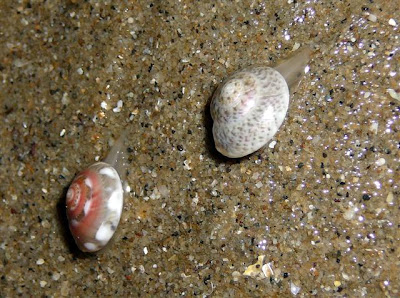The super low tides are here again and this time round, I will be mostly recceing for my sand star project. With Ria helping me check Pasir Ris, a team of five (Chay Hoon, Vyna, Mei Lin, Alex and I) met at Tanah Merah to check out the sand flat that is known to have a lot of button shells and sand dollars.
And without doubt, there are indeed plenty of sand dollars and button shells. But most button shells seem to be dead with just the empty shell.
To my surprise, Chay Hoon found two button shells that are alive. They are snails so you can see their foot sticking out and moving along.
Where there are button shells, there will bound be moon snails. Moon snails are fierce predators prawling around the sand to hunt for preys like button shells.
To our delight, Chay Hoon found a really pretty moon snail with brown stripes on the white shell. I have never seen this before.
If you put it into a container with a hard surface, you can see the whole body fully expanded. What a beauty!
These circular structures are contain egg mass of the moon snail, which explain their abundance in this sand flat.
When moon snails die, that does not mean you can collect the beautiful shells. That is because hermit crabs need shells to live and be protected from predators. The moon snail shell on the right belongs to the tiger moon snail.
Chay Hoon took time to check out the larger sand dollars and we found two keyhole sand dollars! I have never seen them before at all. That's really amazing.
This is the underside. Why do they have slots or "keyholes"? It is suggested that they can help the sand dollar to burrow, upright itself, gather food or to prevent water current from lifting them out of the sand. Cool isn't it?
Of course, with button shells, there are sand stars which is the subject I'm more interested in. Though there aren't many, we found seven today which is already not bad. Ria smsed me that she found a lot at Pasir Ris. Can't wait to see her blog post when she does it.
We did measurements on them.
And also checking, by touch, if they have shells within their stomach. Indeed, two of the seven stars contain button shells within them.
A sandy habitat means you can also find acorn worms. This is actually the cast of the processed sand. Can you see the yellow bit where the butt of the acorn worm is? Hehe.
Like past East Coast trips, seagrasses were washed upshores. We wonder where the seagrasses came from? Is there a hidden meadow at East Coast/Tanah Merah area?
There are some bits of algae around too, and this one has a sea squirt on it.
In pools of water there are also swimming crabs like this one, and also moon crabs which are almost impossible to photograph since they burrow within seconds.
This cone snail lookalike is actually an olive snail, which might be the one I saw at Cyrene Reef.
In pools of water, fishes were swimming about gracefully, like this cute rabbitfish.
This is another big fish which I don't know what is it.
And it looks like the tiny algae patches are perfect spots for them to hide and rest during low tide.
Last but definitely not the least, is another new discovery for me, found by Chay Hoon again! Yay. They are chitons which are actually molluscs. They mostly eat algae, bryozoans and sometimes bacteria.
Here's a closeup of each chiton, nice to see two different colours!
Grateful again for them to come and help me hunt for sand stars and button shells today! Thanks Vyna for the rides as well. Many more trips to go and looking forward to them.
Tuesday, June 3, 2008
Sandflat at Tanah Merah
Subscribe to:
Post Comments (Atom)

























1 comment:
*Is jealous*
How I wish I was free to go out on the trips for this week.
Oh, those are larger rabbitfish.
Post a Comment